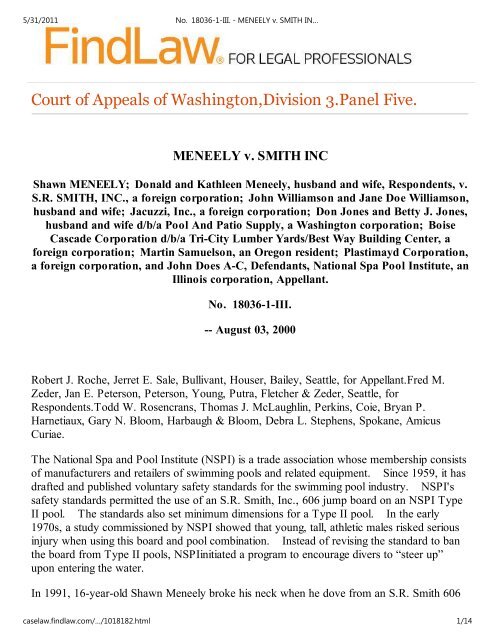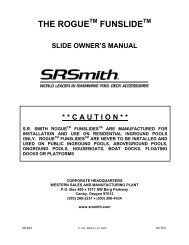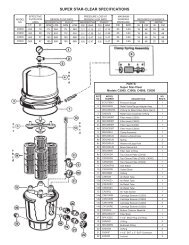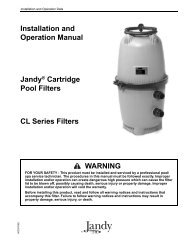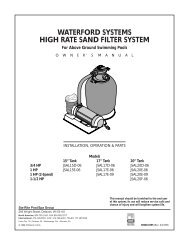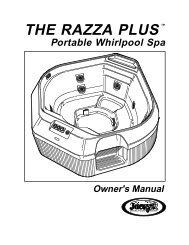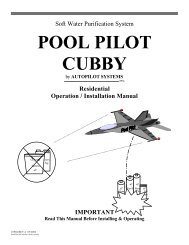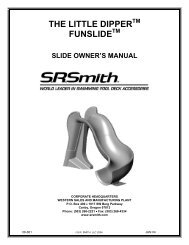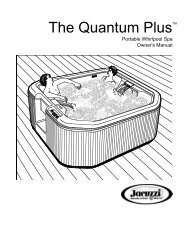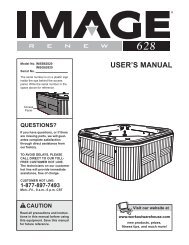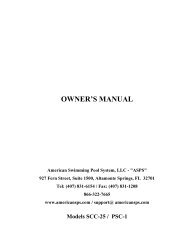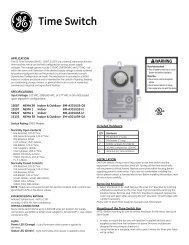Meneely v Smith - Rick English - Swimming Pool Consultant
Meneely v Smith - Rick English - Swimming Pool Consultant
Meneely v Smith - Rick English - Swimming Pool Consultant
Create successful ePaper yourself
Turn your PDF publications into a flip-book with our unique Google optimized e-Paper software.
5/31/2011 No. 18036-1-III. - MENEELY v. SMITH IN…Court of Appeals of Washington,Division 3.Panel Five.MENEELY v. SMITH INCShawn MENEELY; Donald and Kathleen <strong>Meneely</strong>, husband and wife, Respondents, v.S.R. SMITH, INC., a foreign corporation; John Williamson and Jane Doe Williamson,husband and wife; Jacuzzi, Inc., a foreign corporation; Don Jones and Betty J. Jones,husband and wife d/b/a <strong>Pool</strong> And Patio Supply, a Washington corporation; BoiseCascade Corporation d/b/a Tri-City Lumber Yards/Best Way Building Center, aforeign corporation; Martin Samuelson, an Oregon resident; Plastimayd Corporation,a foreign corporation, and John Does A-C, Defendants, National Spa <strong>Pool</strong> Institute, anIllinois corporation, Appellant.No. 18036-1-III.-- August 03, 2000Robert J. Roche, Jerret E. Sale, Bullivant, Houser, Bailey, Seattle, for Appellant.Fred M.Zeder, Jan E. Peterson, Peterson, Young, Putra, Fletcher & Zeder, Seattle, forRespondents.Todd W. Rosencrans, Thomas J. McLaughlin, Perkins, Coie, Bryan P.Harnetiaux, Gary N. Bloom, Harbaugh & Bloom, Debra L. Stephens, Spokane, AmicusCuriae.The National Spa and <strong>Pool</strong> Institute (NSPI) is a trade association whose membership consistsof manufacturers and retailers of swimming pools and related equipment. Since 1959, it hasdrafted and published voluntary safety standards for the swimming pool industry. NSPI'ssafety standards permitted the use of an S.R. <strong>Smith</strong>, Inc., 606 jump board on an NSPI TypeII pool. The standards also set minimum dimensions for a Type II pool. In the early1970s, a study commissioned by NSPI showed that young, tall, athletic males risked seriousinjury when using this board and pool combination. Instead of revising the standard to banthe board from Type II pools, NSPIinitiated a program to encourage divers to “steer up”upon entering the water.In 1991, 16-year-old Shawn <strong>Meneely</strong> broke his neck when he dove from an S.R. <strong>Smith</strong> 606caselaw.findlaw.com/…/1018182.html 1/14
5/31/2011 No. 18036-1-III. - MENEELY v. SMITH IN…jump board into a pool owned by Mr. and Mrs. John Williamson. The fracture paralyzedhim from the neck down. Mr. <strong>Meneely</strong> sued several defendants, including NSPI. Thesuperior court held that NSPI owed him and other consumers a duty to exercise due care informulating its safety standards and to warn them about the risk of injury. The court basedits decision on the voluntary rescue doctrine, as set forth in Brown v. MacPherson's, Inc., 86Wash.2d 293, 545 P.2d 13 (1975). The jury found NSPI breached its duty and was theproximate cause of 60 percent of Mr. <strong>Meneely</strong>'s $11 million in damages.NSPI appeals. The primary issue on review is whether a trade association such as NSPIowes a duty of care to the ultimate consumer. We hold it does when it undertakes the taskof setting safety standards and fails to change those standards or issue warnings after itbecomes aware of a risk posed by the standards. We therefore affirm.FACTSMr. <strong>Meneely</strong> described the dive that rendered him a quadriplegic, as follows: He stated heran from the rear of the board, hopped on the end, and dove headfirst into the pool, witharms and legs extended, then drew his limbs into his body before entering the water. Hishead hit the pool's transition slope, which is the slope between the floor of the deep end of thepool and the beginning of the pool's shallow portion. Mr. <strong>Meneely</strong> was using the pool as aguest of Mr. Williamson's grandson.On March 19, 1993, Mr. <strong>Meneely</strong> and his parents Donald and Kathleen <strong>Meneely</strong> (hereafterreferred to collectively as Mr. <strong>Meneely</strong>) filed this lawsuit against Mr. and Mrs. Williamson(hereafter Mr. Williamson) and various “John Doe” defendants, alleging causes of action fornegligence, products liability, and breach of express and implied warranties. Mr. <strong>Meneely</strong>subsequently amended his complaint to name as defendants the manufacturer and the retailerof the pool liner, the manufacturer and the retailer of the diving board, and NSPI.Mr. <strong>Meneely</strong> claimed that the defendants were liable to him because they represented toconsumers such as Mr. Williamson that the board he purchased was safe to use in his pool.Specifically, in 1965, Mr. Williamson purchased a “hopper bottom” pool that Mr. <strong>Meneely</strong>contended was an NSPI Type II pool. At the same time, Mr. Williamson installed a divingboard. In 1974, Mr. Williamson replaced the original board with one of a like kindmanufactured by S.R. <strong>Smith</strong>. He bought the board from Don Jones of <strong>Pool</strong> and PatioSupply, and Mr. Jones's employees installed it. A label affixed to the new board stated thatit was designed for use in NSPI Type II pools. According to Mr. <strong>Meneely</strong>, NSPI knew nolater than 1971 that the S.R. <strong>Smith</strong> board was unsafe for use in Type II pools, but it did notchange its safety standard.Mr. <strong>Meneely</strong> entered stipulated orders dismissing the defendants other than NSPI before trial.NSPI unsuccessfully moved to dismiss Mr. <strong>Meneely</strong>'s lawsuit against it on the ground hefiled the suit outside the time period prescribed by the construction statute of repose, RCW4.16.310. The court also rejected NSPI's additional motion for summary judgment on thecaselaw.findlaw.com/…/1018182.html 2/14
5/31/2011 No. 18036-1-III. - MENEELY v. SMITH IN…issues of (1) whether it owed a duty of reasonable care to Mr. <strong>Meneely</strong> in formulating itssafety standards, and (2) whether the alleged deficiency in its safety standards was theproximate cause of Mr. <strong>Meneely</strong>'s injuries.The evidence at trial focussed first on whether Mr. Williamson's pool was an NSPI Type IIpool. A Type II pool measures 7 feet 6 inches at its deepest point, and 22 feet from theback wall of the deep end to the top of the transition slope.1 Its transition slope has a 3:1rise.2 Mr. Williamson's pool is 7 feet 9 inches at its deepest point, and measures 19 feet tothe top of the transition slope. Its slope has a 2:1 rise. Although Mr. <strong>Meneely</strong>'s expertwitnesses admitted that the dimensions of Mr. Williamson's pool did not exactly match theminimum dimensions of the Type II pool, they were of the opinion that its dimensions were“within practical limits” the same. Specifically, the slopes matched in the critical area whereMr. <strong>Meneely</strong> hit his head. Merle Dowd, who was the director of special projects for NSPIin the early 1970s, testified that in his experience, “all pools that were manufactured wherethe parts were components ․ put together on site and ․ had a vinyl liner that was made to fitthat design ․ were consistent with the NSPI standards.” (Emphasis added.) Thisconsistency enabled consumers to install pools without having to order each part custommade.Mr. <strong>Meneely</strong> also introduced evidence that the jump board was unsafe for use in an NSPIType II pool. In 1981, a study performed for the Council for National Cooperation inAquatics demonstrated that the Type II pool was unsafe for use with a diving board such asthe S.R. <strong>Smith</strong> 606 jump board. And, expert analysis of studies performed by Dr. GaleMargaret Gehlsen of Ball State University for the Consumer Products Safety Commissionand for Mr. <strong>Meneely</strong>'s lawsuit reached similar conclusions. From an underwater viewingroom, Dr. Gehlsen videotaped divers in a much deeper pool, then superimposed thedimensions of the Type II pool over their trajectories. Dr. Gehlsen's assistant in that studywas John Wingfield, who at the time of trial was the director and head coach of the IndianaRegional Training Center for United States Diving. Based upon the data gathered in thesestudies, he stated that a diver of Mr. <strong>Meneely</strong>'s height and weight who executed a two-stepdive and catapulted from a jump board would impact the pool's transition slope at velocitiessufficient to break his neck. Kim William Tyson, aquatics coordinator at the University ofTexas, agreed. Mr. Tyson called a 606 jump board on a Type II pool “the most dangerouscombination ․ out there[.]”Finally, Mr. <strong>Meneely</strong> presented evidence that by the early 1970s, and before Mr. Williamsoninstalled his replacement board in 1974, NSPI knew of the risk associated with the use of thejump board in Type II pools. Yet, NSPI did not change the safety standard that permitteduse of these boards. Milton Costello is a consulting engineer who was a member of NSPIand had participated in formulating NSPI safety standards. He testified that in 1971 peoplein the industry were focusing on safety concerns because of lawsuits brought by personsinjured while diving. In addition, the Consumer Products Safety Commission was critical ofNSPI standards. In the Commission's view, the standards “lack[ed] [the] technical rationalecaselaw.findlaw.com/…/1018182.html 3/14
5/31/2011 No. 18036-1-III. - MENEELY v. SMITH IN…required to quantify the safe physical parameters” for use of boards in residential pools,because they were not premised upon safety performance tests. Mr. Dowd admitted thatthe periodical, <strong>Swimming</strong> <strong>Pool</strong> Weekly, correctly quoted him as stating at a round tablediscussion held at NSPI's national convention in 1971, as follows: “Increasingly, as I've beenvisited by lawyers in Washington [D.C.], they're looking deeper. And I think that when thestakes get high enough, they're going to want to look at the standards makers[.]” (Emphasisadded.) He drew this conclusion from the questions the lawyers were asking, such as,“[w]ho made these standards? ․ How were these standards drawn and for what reasons?Were they drawn so you could manufacture this pool or you could build this pool? Or werethey drawn because of an abiding concern for safety of people that are going to use them?”(Emphasis added.)Larry Paulick was NSPI's technical director from 1972 to 1974. He testified that in 1973NSPI hired the Arthur D. Little Corporation (ADL), a Cambridge, Massachusetts researchfirm, to perform diving tests. On June 10, 1974, ADL issued the report of Dr. Richard S.Stone. Dr. Stone concluded that “[w]ithin practical limits of pool design depth for either arunning dive or from a spring or jump board of 1 meter height, it is not possible to rely onlyon the slowing effect of the water to assure that the diver will not impact the bottom of thepool at dangerous velocities.” (Emphasis added.)Lief Zars is a pool designer and builder who chaired the standards and codes committee forNSPI's Technical Council in 1974. He was the liaison between ADL and NSPI. He testifiedthat following receipt of the Stone Report, the standards and codes committee determinedmore tests were needed. In October 1974, the diving board subcommittee reported that “foreither a running dive or a dive from a diving board or jump board, the primary protectivemechanism is the action of the diver rather than the slowing effects provided by the passageof his body through water.” (Emphasis added.) In other words, since very few divers wereinjured, the subcommittee determined that the divers must be using their hands and arms tosteer up as soon as they entered the water. Accordingly, NSPI decided not to change thestandard. Instead, it published a brochure entitled, “The Sensible Way to Enjoy Your <strong>Pool</strong>”that described the steering up technique, and sent it to its members to distribute with theirproducts.On the strength of this evidence, the jury found NSPI liable to Mr. <strong>Meneely</strong> for negligence,and responsible for 60 percent of their $11 million in damages. NSPI appeals, contending(1) the construction statute of repose barred Mr. <strong>Meneely</strong>'s claim; (2) it owed no duty to Mr.<strong>Meneely</strong>; (3) its safety standards were not the proximate cause of Mr. <strong>Meneely</strong>'s injuries;and (4) the court's rulings on several evidentiary questions prejudiced it.We set forth additional facts below, with the issues they concern.analysis1. Statute of Repose.caselaw.findlaw.com/…/1018182.html 4/14
5/31/2011 No. 18036-1-III. - MENEELY v. SMITH IN…Lewis Refrigeration Co., 101 Wash.2d 106, 110, 676 P.2d 466 (1984). “RCW 4.16.300 and.310 were adopted to protect architects, contractors, engineers, surveyors and others fromextended potential tort and contract liability.” Hudesman v. Meriwether Leachman Assocs.,Inc., 35 Wash.App. 318, 321, 666 P.2d 937 (1983) (citing Pinneo v. Stevens Pass, Inc., 14Wash.App. 848, 545 P.2d 1207 (1976)). “The protection is based on the premise that thelonger the owner possesses the improvement, ‘the more likely it is that the damage was theowner's fault or the result of natural forces.’ ” Pfeifer v. City of Bellingham, 112 Wash.2d562, 568, 772 P.2d 1018 (1989) (quoting Jones v. Weyerhaeuser Co., 48 Wash.App. 894,899, 741 P.2d 75 (1987)). In further discerning the purpose of RCW 4.16.300, the court inCondit relied upon the statute's language, which lists various construction activities, “includingdesigning, planning, surveying, architectural, or construction or engineering services,” assubject to the six-year accrual period. Condit, 101 Wash.2d at 110, 676 P.2d 466. Thecourt observed these activities concerned the process of building a structure. Id. The court,therefore, concluded that the statute applied to individuals whose activities related to buildingthe improvement. Id. at 111, 676 P.2d 466.Here, NSPI's general counsel, David Karmol, testified that NSPI did not build or design poolsor pool products. He stated that NSPI standards are not a blueprint for any particular pool;rather they set forth recommended, minimum dimensions. At argument on the summaryjudgment motion, Mr. <strong>Meneely</strong>'s attorney noted that NSPI's standards can be applied tovarying pool designs. He argued that the pool “could be kidney shaped. It could be Lshaped. It could be round. This pool could be of any length. It could be 30 feet long.It could be 120 feet long and still comply with NSPI standards.” It follows that theformulation of a safety standard applicable to all swimming pools that are intended for usewith a diving board, is different in kind from the design of a particular swimming pool, inwhich the minimum dimensions of the safety standard are encompassed. RCW 4.16.310applies to the latter activity, but not to the former.NSPI makes much of the fact that Mr. <strong>Meneely</strong>'s attorney characterized NSPI's standard as a“product” rather than a “service,” but at trial three years later proceeded under a common lawnegligence theory rather than a products liability theory. The attorney's characterization isimmaterial. NSPI's duty of care did not arise from either a service provided duringconstruction or from a role as a manufacturer of a product. It arose from its voluntaryassumption of the task of formulating safety standards, knowing that the pool industry wouldconform its products to those standards. See Issue 2 infra. The latter duty does not fallwithin RCW 4.16.300.3The superior court correctly held that the six-year statute of repose did not apply to Mr.<strong>Meneely</strong>'s action against NSPI.2. Duty of Care.NSPI assigns error to the superior court's determination, as a matter of law, that it owed Mr.<strong>Meneely</strong> a duty to exercise reasonable care when it formulated and promulgated its safetycaselaw.findlaw.com/…/1018182.html 6/14
5/31/2011 No. 18036-1-III. - MENEELY v. SMITH IN…standards. NSPI argues that the voluntary rescue doctrine does not support the superiorcourt's holding.Whether a duty exists is a question of law. Hartley v. State, 103 Wash.2d 768, 778-79,698 P.2d 77 (1985). Here, the court held that “NSPI owed [Mr. <strong>Meneely</strong>] a continuingduty, based upon Washington common law [Brown v. MacPherson's, Inc., 86 Wash.2d 293,545 P.2d 13 (1975) ] ․, to exercise reasonable care in the development, formulation anddissemination of its residential swimming pool standards[.]” Further, NSPI owed consumerssuch as Mr. <strong>Meneely</strong> a duty of care “in the development, formation and dissemination ofinstructions and warnings with respect to the safe use of its member[s'] residential pool anddiving board products[.]” Accordingly, it denied NSPI's motion for summary dismissal ofMr. <strong>Meneely</strong>'s negligence claim.The voluntary rescue doctrine is a well established liability concept. In Brown, 86 Wash.2dat 299, 545 P.2d 13, the court recognized that in certain circumstances, a person may beliable in negligence if he or she gratuitously assumes a duty to act on behalf of another andfails to act with due care in performing that duty. The plaintiffs there had sued the State,alleging that an employee of the real estate division of the Washington Department of MotorVehicles assumed such a duty. The employee had been approached by a noted avalancheexpert who informed him that the plaintiffs' cabins were in a high risk avalanche area. Theemployee led the expert to believe he would convey the warning to the plaintiffs. Instead,the employee met with the plaintiffs' real estate broker and indicated no danger existed.The court in Brown held at page 299, 545 P.2d 13 that the plaintiffs' allegations stated apossible cause of action for misfeasance; i.e., “ the State's agents undertook to prevent theavalanche damage by conferring with [the real estate broker], in effect to rescue [theplaintiffs] from their danger, but in the process ․ negligently misled [the broker] and thusmade [the plaintiffs'] situation worse.” The court relied upon prior Washington case law forthe proposition that “[o]ne who undertakes, albeit gratuitously, to render aid to or warn aperson in danger is required by our law to exercise reasonable care in his efforts, howevercommendable.” Id. And, if the rescuer does not exercise reasonable care and therebyincreases the risk of harm to the other person, he is liable for damages.The court in Brown also held that under the facts alleged by the plaintiffs, the State could beheld liable for nonfeasance; i.e., the representation of the State employee to the avalancheexpert that he would take care of the matter caused the expert to refrain from warning theplaintiffs himself. In other words, the State assumed a duty to warn, upon which the expertrelied, then did not perform the duty.One of the prior Washington cases Brown relied upon is Sheridan v. Aetna Cas. & Sur. Co.,3 Wash.2d 423, 100 P.2d 1024 (1940). There, an employee of a tenant in the Stirratbuilding in Seattle fell down the shaft of the building's freight elevator. The elevator's doorshad failed to close after the car left the floor and before the plaintiff arrived. The plaintifffell when he stepped into the shaft, believing the car was there. He sued and named as acaselaw.findlaw.com/…/1018182.html 7/14
5/31/2011 No. 18036-1-III. - MENEELY v. SMITH IN…defendant the insurance company that had agreed under the terms of the owner's policy toinspect the building's elevators on a periodic basis and file with the city a copy of the report.A city ordinance made it unlawful for the owner of any freight or passenger elevator tomaintain or operate the same without regular safety inspections. The ordinance alsorequired the safety inspector to file a report with the city. The court concluded that theinsurer was liable to the plaintiff in negligence “because of the legal responsibility attaching toits voluntary assumption, as the owner's agent, of the duty of proper inspection and reportingto the city.” Id. at 439, 100 P.2d 1024.In Folsom v. Burger King, 135 Wash.2d 658, 958 P.2d 301 (1998), the plaintiffs also sought,this time unsuccessfully, to impose liability on a defendant under the voluntary rescuedoctrine. There, the plaintiffs' decedents, employees of a fast food restaurant, weremurdered during a robbery. At some point during the robbery, one of the decedents hadactivated the defendant's security system alarm. The defendant did not answer the alarmbecause the restaurant owner had discontinued the service about one year earlier. Theplaintiffs argued that the employees reasonably believed that the defendant's security systemcontinued to offer protection because the defendant had not removed the system from therestaurant. Therefore, the company was liable for damages for their deaths.The court held that the plaintiffs in Folsom had not established that the voluntary rescuedoctrine applied in that case. The court stated that “[t]he duty to rescue [or to warn] ariseswhen a [defendant] knows a danger is present and takes steps to aid an individual in need.”Id. at 677, 958 P.2d 301. “Typically, liability for attempting a voluntary rescue has beenfound when the defendant makes the plaintiff's situation worse by: (1) increasing the danger;(2) misleading the plaintiff into believing the danger had been removed; or (3) depriving theplaintiff of the possibility of help from other sources.” Id. at 676, 958 P.2d 301 (citing w.Page Keeton et. al, Prosser and Keeton on the Law of TortsS § 56 (5th ed.1984)). Thecourt concluded the security company was not liable because the company's failure to removethe security system did not create an ongoing duty to rescue the employees from unknowndangers, and the company's inaction did not create the danger to the employees.In arguing the voluntary rescue doctrine imposes liability on NSPI in his case, Mr. <strong>Meneely</strong>relies upon several facts, including that NSPI publishes the swimming pool and equipmentindustry's only comprehensive set of safety standards. The standards cover all aspects ofswimming pools and pool equipment. The Council of American Building Officials and theInternational Conference of Building Officials have adopted some or all of the NSPIstandards, and the International Residential Code and Southern Building Code haveincorporated some or all of those standards into their codifications.Also, in reviewing its standards for diving boards, NSPI undertook testing, the results ofwhich indicated a risk of severe injury to persons like Mr. <strong>Meneely</strong> who used the boards.NSPI nevertheless decided to retain the existing pool and board combinations and initiated the“steer up” program to address the risk. It instructed its members to refer to the standards incaselaw.findlaw.com/…/1018182.html 8/14
5/31/2011 No. 18036-1-III. - MENEELY v. SMITH IN…their product literature and to mark instructions and packaging suitably as to pool type “[f]or[their] own protection.” NSPI also instructed its members to affix conspicuous labels totheir products, warning that diving equipment, if installed, must meet NSPI standards for thetype of pool.NSPI members relied on the standards. As set forth earlier, Mr. Dowd stated that in hisexperience everyone in the pool industry conformed to the standards. Jacuzzi, Inc., includedNSPI's depth standard as part of its catalog for diving boards. S.R. <strong>Smith</strong> printed referenceto the standard on the diving board in this case. The label read, “TO BE INSTALLED ONPOOL WITH 7 1/212 FT. DEPTH OR GREATER (TYPE II POOL) Per, N.S.P.I.Specifications Section 211 -Jan. 1, 1972.” Plastimayd Corporation, the company thatmanufactured Mr. Williamson's replacement liner, included a copy of the standard with itsproduct. Both the presidents of S.R. <strong>Smith</strong> and of Plastimayd testified their companiesrelied upon NSPI standards. NSPI members who elected to derate their board from Type IIpools would have been at a competitive disadvantage. Members followed the standard outof economic imperative.We hold the foregoing facts fall squarely within the voluntary rescue doctrine. Bypromulgating industry wide safety standards that pool and board manufacturers relied upon,NSPI voluntarily assumed the duty to warn Mr. <strong>Meneely</strong> and other divers of the risk posedby this type of board on a Type II pool. It failed to exercise reasonable care in performingthat duty, when it did not change the standard after it knew that studies showed the pool andboard combination was dangerous for certain divers.NSPI's attempt to distinguish Brown is not persuasive. It argues that the harm here was notimminent and that its connection with the consumer was too attenuated to impose liability.We disagree with NSPI. The evidence at trial showed that any diver of Mr. <strong>Meneely</strong>'sapproximate age, height, weight, and athletic build was at risk using this board and poolcombination. And, the connection between NSPI and Mr. <strong>Meneely</strong> was no more attenuatedthan in Sheridan, which Brown relied upon in its holding. There, the insurer was held toowe a duty of care to the elevator user when it assumed the responsibility of inspecting theelevator for its owner. NSPI likewise owed Mr. <strong>Meneely</strong> a duty of care when it assumedthe responsibilities of the manufacturers and retailers of the pool and board, for setting poolsafety standards.Folsom is distinguishable, based in part upon the foreseeability of the harm. “ ‘Theultimate test of a duty to use [due] care is found in the foreseeability that harm may result ifcare is not exercised.’ ” King v. National Spa & <strong>Pool</strong> Inst., Inc., 570 So.2d 612, 615, 1A.L.R. 5th 1109 (Ala.1990) (quoting Bush v. Alabama Power Co., 457 So.2d 350, 353(Ala.1984)). “ ‘ “Without evidence that a defendant knew or reasonably should have knownthere was any danger or potential danger associated with that defendant's act or failure to act,any imposition of liability would in essence be the imposition of liability without fault.” ’ ”N.N.V. v. American Ass'n of Blood Banks, 75 Cal.App.4th 1358, 1376, 89 Cal.Rptr.2d 885caselaw.findlaw.com/…/1018182.html 9/14
5/31/2011 No. 18036-1-III. - MENEELY v. SMITH IN…Proximate cause has two distinct elements: cause in fact and legal causation. Schooley v.Pinch's Deli Market, Inc., 134 Wash.2d 468, 478, 951 P.2d 749 (1998). Cause in fact isbased on the physical connection between an act and an injury; i.e., whether the defendant'sact was the actual or “but for” cause of the plaintiff's injury. That determination is generallyleft to the jury. Id. In contrast, “legal cause is grounded in policy determinations as to howfar the consequences of a defendant's acts should extend.” Id. “The focus in the legalcausation analysis is whether, as a matter of policy, the connection between the ultimate resultand the act of the defendant is too remote or insubstantial to impose liability.” Id. at 478-79,951 P.2d 749. “A determination of legal liability will depend upon ‘ “mixed considerations oflogic, common sense, justice, policy, and precedent.” ’ ” Id. at 479, 951 P.2d 749 (quotingKing v. City of Seattle, 84 Wash.2d 239, 250, 525 P.2d 228 (1974)). Issues of duty andlegal causation are intertwined. Schooley, 134 Wash.2d at 479, 951 P.2d 749. “However,a court should not conclude that the existence of a duty automatically satisfies the requirementof legal causation.” Id. “Legal causation is ․ a concept that permits a court for sound policyreasons to limit liability where duty and foreseeability concepts alone indicate liability canarise.” Id.The jury here considered the following evidence on the issue of causation: Jordan Votja, thecontractor who subcontracted the excavation work in Mr. Williamson's yard for the pool in1965, did not rely upon NSPI specifications. Rather, the excavation was the same size asthose he had provided for other “hopper bottom” pool installations. The original vinyl poolliner and the replacement liner that was manufactured by Plastimayd and installed in 1981, fitthe excavation, although it was of slightly different dimensions than the dimensions specifiedin NSPI's safety standards for Type II pools. Mr. Dowd, a former NSPI executive, testifiedthat, to the best of his knowledge, all manufactured pools with vinyl liners were madeconsistent with NSPI standards for Type II pools. Experts retained by Mr. <strong>Meneely</strong> testifiedthat Mr. Williamson's pool was, for all practical purposes, the same as an NSPI Type II pool.Don Jones of <strong>Pool</strong> and Patio Supply sold Mr. Williamson the S.R. <strong>Smith</strong> 606 jump board in1974 to replace his existing board. His employees installed the new board on Mr.Williamson's pool. Mr. Jones testified he did not measure Mr. Williamson's pool because hereplaced the existing board with one of a like kind. Mr. Jones was a member of NSPI.When Mr. Williamson purchased the new board, NSPI already had commissioned andreceived the results of the Stone Report that stated that the slowing effect of the water wasinsufficient to keep a diver from impacting the pool bottom of an NSPI Type II pool.The court also admitted a letter written in October 1982 by Dr. Robert Weiner, a consultingengineer, to NSPI Vice-President Larry Paulick. Dr. Weiner recommended that jumpboards be banned from Type II pools. NSPI did not do so. At about this same time, itissued a “NSPI Consumer Awareness Bulletin,” which addressed consumer questions aboutpool safety, including the safety of diving boards. The bulletin included the following:Q Why not ban all diving boards?caselaw.findlaw.com/…/1018182.html 11/14
5/31/2011 No. 18036-1-III. - MENEELY v. SMITH IN…A Statistics show that fewer than 5% of the diving accidents occur in the deep or divingend. Even without a diving board, a person can achieve the same water impact and velocityfrom a running dive off the side of the pool.Q What if pools with diving boards were deeper and/or longer, wouldn't they be safe?A Critics who say deeper and/or longer is safe are doing the consumers an injustice byleading them into a false sense of security.• Industry studies indicate that it takes in excess of 22 feet before the body slows downsufficiently to prevent serious spinal cord injury.• Exact measurements of length and depth are not as important as being aware of the properway to dive.․Q Should depth warnings be mandated on residential pools?A No. It's unlikely that depth warnings would have a significant effect on injuries, becausestatistical information has shown that the residential pool diving victim was familiar with thepool and had been using it prior to the accident.․Q What is the industry doing to address diving safety?A The industry has supported studies over the last eight years to provide solutions thatwould reduce the number of diving accidents. On the basis of these studies a diver trainingprogram has been instituted.Q Has the industry considered safety solutions such as removing the diving board, softbottoms, non-slip bottoms, deeper pools?A All of these solutions, and many more, have been considered. Invariably for everysuggested solution to a specific problem, a new hazard has been discovered or the suggestionhas been proved to be ineffective.For example: Soft bottoms can trap the diver's head like a catcher's mitt, promoting anaccident where one may not have occurred.Q Does the industry have a good solution for diving accidents?A Independent research has shown that proper training is the solution for reducing theserelatively few but serious accidents.caselaw.findlaw.com/…/1018182.html 12/14
5/31/2011 No. 18036-1-III. - MENEELY v. SMITH IN…The foregoing evidence presented disputed issues of fact as to causation, which the jurydecided in Mr. <strong>Meneely</strong>'s favor. Mr. Williamson's pool varied slightly from the NSPIstandards in depth, distance to the top of the transition slope, and in the ratio of the slope'srise. But, Mr. <strong>Meneely</strong>'s experts testified that it was “substantially” the same as a Type IIpool, particularly at the point on the transition slope where Mr. <strong>Meneely</strong> hit headfirst. Otherevidence presented by Mr. <strong>Meneely</strong> showed that NSPI did nothing to warn consumers of therisk, even though national lists of pool owners were available.We hold the evidence and the reasonable inferences therefrom support the jury's findings thatNSPI negligently caused Mr. <strong>Meneely</strong>'s injuries when it (1) formulated a safety standard thatpermitted this type of board on a Type II pool, and (2) did not warn consumers when itsresearch revealed the risk in the early 1970s. See Hojem v. Kelly, 93 Wash.2d 143, 145,606 P.2d 275 (1980).NSPI also argues that Mr. <strong>Meneely</strong>'s injuries are too remote from NSPI's acts to establishliability on its part. The argument appears to raise a question of legal causation, but NSPIdoes not detail why justice, common sense, and policy, see Schooley, 134 Wash.2d at 479,951 P.2d 749, would call for a determination that it is not the legal cause of Mr. <strong>Meneely</strong>'sinjuries. NSPI does point out that it had no input in the size, placement, or design of thesticker S.R. <strong>Smith</strong> placed on its diving board to advise the consumer that it was appropriatefor a pool seven and one-half feet deep per NSPI 1972 specifications. But, since the labelaccurately represented NSPI's safety standard, this fact does not aid NSPI.Affirmed.5The remainder of this opinion has no precedential value. Therefore, it will be filed for publicrecord in accordance with the rules governing unpublished opinions.FOOTNOTES1. NSPI's 1961, 1972, 1974, 1978, and 1987 standards varied slightly in the minimum,recommended dimensions for a Type II pool.2. For every three feet of its length, the depth of the transition slope decreased by onefoot.3. This court notes that NSPI's reliance upon McCulloch v. Fox & Jacobs, Inc., 696S.W.2d 918 (Tex.Ct.App.1985) for the proposition that the statute of repose bars claims forfailure to warn, is misplaced. There, the plaintiff sued a developer for damages resultingfrom injuries he sustained when he dove into the unmarked shallow end of a community pool.He incurred the injuries more than a dozen years after the pool was built. The court heldthat the developer, “with respect to building the pool, ․ functioned not as an owner but as abuilder or supervisor” and, therefore, was protected by the statute of repose. Id. at 922.The court's holding was not based upon the fact the alleged defect was a failure to warn ofcaselaw.findlaw.com/…/1018182.html 13/14
5/31/2011 No. 18036-1-III. - MENEELY v. SMITH IN…the danger.4. The superior court held, in the alternative, that NSPI owed Mr. <strong>Meneely</strong> a duty of careunder Restatement (Second) of Torts § 324A (1965). That section has not yet beenadopted by a Washington court. It provides, as follows:One who undertakes, gratuitously orfor consideration, to render services to another which he should recognize as necessary forthe protection of a third person or his things, is subject to liability to the third person forphysical harm resulting from his failure to exercise reasonable care to protect his undertaking,if(a) his failure to exercise reasonable care increases the risk of such harm, or(b) he hasundertaken to perform a duty owed by the other to the third person, or(c) the harm issuffered because of reliance of the other or the third person upon the undertaking.Since thesuperior court's holding is sustainable under Washington law, as set forth in Brown, we do notaddress this issue.5. The National Electrical Manufacturers Association, the American Society of AssociationExecutives, and the Washington State Trial Lawyers Association Foundation filed amici curiaebriefs in this appeal. The Electrical Manufacturers and the Association Executives expressconcern that the imposition of tort liability would chill important trade association researchand development activities, “thereby having the net effect of decreasing product safetyoverall.” We recognize their concern, but we also point out that the narrow holding hereneed not have that effect. Specifically, NSPI did not change its safety standard after theStone Report, which NSPI itself commissioned, indicated the diving board was unsafe for usein Type II pools. NSPI should have known that the pool and board combination wasunsafe, yet it did nothing to warn consumers of the risk. The forseeability of the risk ofharm distinguishes this case.SCHULTHEIS, J.KURTZ, C.J., and BROWN, J., concur.Copyright © 2011 FindLaw, a Thomson Reuters business. All rights reserved.caselaw.findlaw.com/…/1018182.html 14/14


